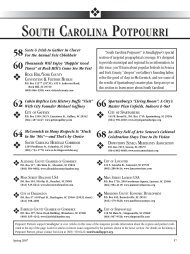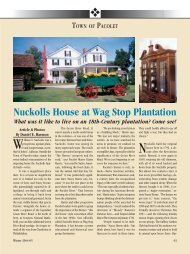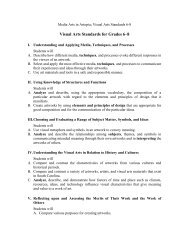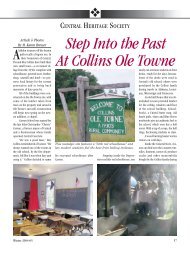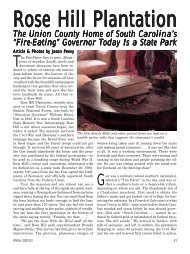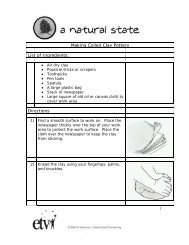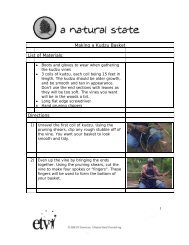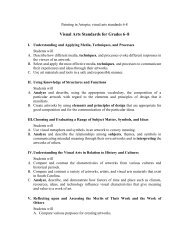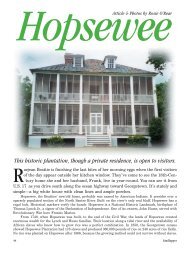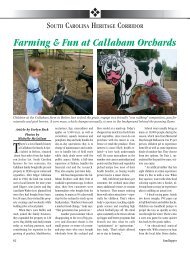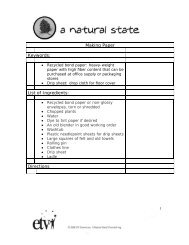The Case Of The Physical Fitness Challenge - Knowitall.org
The Case Of The Physical Fitness Challenge - Knowitall.org
The Case Of The Physical Fitness Challenge - Knowitall.org
Create successful ePaper yourself
Turn your PDF publications into a flip-book with our unique Google optimized e-Paper software.
Pairing Up<br />
Purpose<br />
To construct an arm model<br />
To demonstrate the need for muscle groups<br />
Background<br />
Muscles move by contracting. Muscles can only pull, not push. For this reason, muscles must<br />
work in pairs to move bones in multiple directions. <strong>The</strong> biceps and triceps are muscles located<br />
in the upper arm. <strong>The</strong> biceps are attached on one end to a bone in the shoulder and on the<br />
other end to a bone just below the elbow. You can feel these muscles in the inside of the upper<br />
arm. When they contract, they pull the lower arm up towards the shoulder. <strong>The</strong> triceps are on<br />
the back side of the upper arm. One end of the triceps is attached to a bone in the shoulder,<br />
and the other end of the triceps is attached to a bone just below the elbow. You can feel these<br />
muscles on the outside of the upper arm. When the triceps contract, they pull the lower arm<br />
back down, away from the shoulder. Without the biceps or triceps, the lower arm could not<br />
move up and down.<br />
Teacher Prep<br />
Partially inflate two long, thin-shaped balloons. Do not over inflate them because<br />
they need to bend easily. Tie the ends of the balloons securely. To make inflation<br />
easier, use a hand-held air inflator.<br />
**Caution – Use care when working with balloons. Adult supervision required.<br />
Procedure<br />
1. Estimate the length of your upper arm and the length of your lower arm.<br />
2. Write your estimations in your science journal.<br />
3. Measure the length of your upper arm. Record the measurement in your science<br />
journal.<br />
4. Measure the length of your lower arm. Record the measurement in your science<br />
journal.<br />
5. To create a model of your arm bones, roll 2 sheets of newspaper 2 sheets of paper together clip to make<br />
a tube. Cut the tube so that it is about the same length newpaper as your cut upper to arm bone.<br />
length<br />
6. Tape the ends of the tube closed with masking tape.<br />
7. Roll 2 more sheets of newspaper to make a second tube and make this tube about<br />
the same length as your lower arm bone.<br />
8. Repeat step 7 to make an identical tube for the lower arm. (You should have 3<br />
paper tubes in all.)<br />
9. Put the 2 lower arm bones side by side.<br />
10. Using masking tape, tape the ends of the tubes together so that there is a<br />
small space between the two arm bones. See diagram 1.<br />
11. Using the hole-punch, make a hole in one end of the upper arm model.<br />
12. Punch another hole in one end of the lower arm model.<br />
2005–2006 NASA SCI Files Series<br />
http://scifiles.larc.nasa.gov<br />
13. Stick the pin or paper clip through the holes to connect the upper and lower arm bone models. See diagram 2.<br />
paper clip<br />
14. Label the tube for the upper bone “humerus.”<br />
15. Label the tube on the lower inside of the arm “ulna.”<br />
16. Label the tube on the lower outside of the arm “radius.” See diagram paper clip3.<br />
2 sheets of<br />
newpaper cut to<br />
length<br />
paper clip<br />
paper clip<br />
EG-2005-10-09-LARC <strong>The</strong> <strong>Case</strong> of the <strong>Physical</strong> <strong>Fitness</strong> <strong>Challenge</strong><br />
Humerus<br />
Humerus<br />
31<br />
Segment 1<br />
Materials<br />
6 sheets of newspaper<br />
metric ruler<br />
masking tape<br />
large safety pin or paper<br />
clip<br />
hole-punch<br />
2 long, thin-shaped<br />
balloons<br />
string<br />
1 disposable glove<br />
scissors<br />
science journal<br />
Radius<br />
paperclip<br />
Ulna<br />
2 sheets of<br />
newpaper cut to<br />
length<br />
Radius<br />
Ulna<br />
tape<br />
Humerus<br />
Humerus<br />
Diagram 1<br />
paper clip<br />
Diagram 2<br />
tape<br />
Diagram 3<br />
Radius<br />
paperclip<br />
disposable glove



